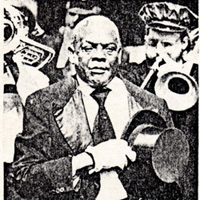The DVD, "New Orleans Jazz Funerals from the inside..." is an excellent documentary on the New Orleans tradition, narrated by
Milton Batiste of Dejan's Olympia Brass Band. It is available here.and on Amazon for $20.00
TIME Magazine ran this article 30 years ago, written by Frank Trippett on the funeral of New Orleans cornet player, Albert Walters. It goes a long way in capturing the sense and sensibility of the jazz funeral tradition.
The Jazz Funeral Tradition
The roots of the jazz funeral date back to 17th Century Africa, where the Dahomeans of Benin and Yoruba of Nigeria, West Africa, laid its foundation. Secret societies of the Dahomeans and Yoruba people assured fellow tribesmen they would receive a proper burial when their time came. To honor this guarantee, resources were pooled in what many consider an early form of life insurance.
This concept remained strong with Africans brought to America as slaves, and as time passed it became a basic principle of the familiar social and pleasure clubs, guaranteeing proper burial to any member who passed. As brass bands gained in popularity in New Orleans, for everything from Mardi Gras to political rallies, they were likewise called on to play processional music for these funeral services.
Eileen Southern, Professor Emerita of Music and Afro-American Studies at Harvard University, in "The Music of Black Americans" wrote, “On the way to the cemetery it was customary to play very slowly and mournfully a dirge, or an ‘old Negro spiritual’ such as ‘Nearer My God to Thee,’ but on the return from the cemetery, the band would strike up a rousing, 'When the Saints Go Marching In,’ or a ragtime song such as 'Didn't He Ramble.'”
In a traditional jazz funeral, the band meets at the church or funeral parlor where the dismissal services are being conducted. After the service, the band leads a procession slowly through the neighborhood to the cemetery. At the conclusion of the interment ceremony, the band leads the procession from the gravesite without playing. Once reaching a respectful distance, the lead trumpet sounds a two-note preparatory riff to alert his fellow musicians. At this point the band sheds its solemnity in favor of lively, joyous music; and family, friends and other celebrants may join in spontaneously behind the band in what is known as the "second line," often brandishing umbrellas or canes while dancing in celebration.
Expression of the tradition outside of New Orleans varies. Often all music is played at the funeral home as part of the service, or at a hall or similar gathering place for a reception. More and more the music is played at a memorial service following cremation. It’s entirely up to the family.
Since the 1970s, brass bands like the Dirty Dozen, the Soul Rebels, Pin Stripe, Algiers, Rebirth, and many others have carried the torch of the jazz funeral. We aspire to make "Band of Praise" worthy of that list, offering an authentic brass band to embrace this tradition.
[**source material from "The Jazz Funeral", originally printed in "The Soul of New Orleans"]


